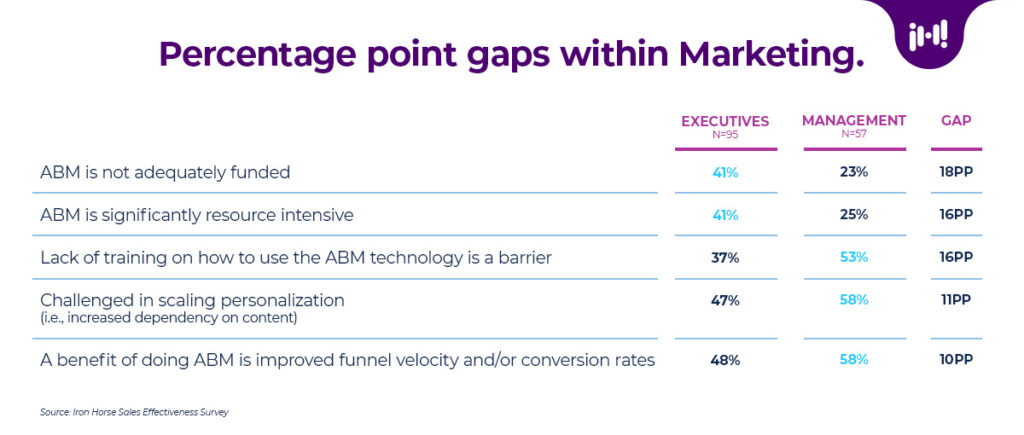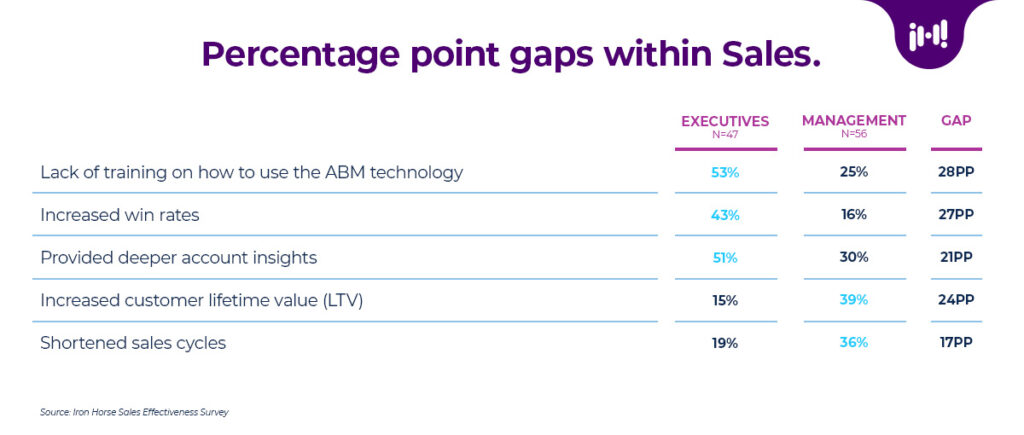Blog

Whether you grew up reading the 1972 book or watching one of the four movie adaptations of Freaky Friday, the plot is consistent. A mother and her daughter don’t get along and simultaneously wish they could change places. Overnight they inexplicably switch bodies and are forced to adapt to the other’s life for one freaky Friday. They experience how difficult it is to be in the other’s shoes and ultimately learn empathy and conflict resolution. (I’m going somewhere with this, I promise.)
Earlier this year, Iron Horse conducted original research to understand the impact of an aligned account-based marketing (ABM) approach on sales effectiveness. We surveyed just over 400 sales and marketing decision-makers at B2B companies with $100 million to $5 billion in revenue. In analyzing the data, we judged “effectiveness” as annual revenue growth of 11%–40% (i.e., high growth).
To be honest, we expected to find that there continue to be significant areas of misalignment between marketers and sellers. This wasn’t the case. Instead, the data demonstrates that, in the most successful companies, these teams have largely come together around ABM, with a shared understanding of its goals, benefits and more. Where gaps do exist, there are concrete ways to close them. (Much more on that in our full report, coming later this month. Subscribe to our blog to make sure you get a copy right when it comes out.)
Instead, we discovered that the biggest disconnect isn’t between Marketing and Sales, but between executives and management within both teams.
Marketing executives vs. marketing managers on ABM.
Where do marketing execs and managers agree?
Marketing executives (n=95) and management (n=57) agree that:
- ABM is defined as “a strategic approach where sales and marketing efforts are focused on targeting specific set accounts, rather than the broader market.” Agreement on the definition is the first step in surviving the first 6 months of an ABM approach!
- A top barrier is that “target accounts assigned to sellers don’t match marketing’s targeting approach.”
- A top drawback of doing ABM is that it “highlighted dependency on data accuracy.”
- Their ABM approach has benefited the organization by enhancing the customer experience and improving lead quality.
That’s where the similarities end.
Where is the misalignment within Marketing?
Marketing executives are more likely than marketing management to believe that:
- ABM is not adequately funded
- ABM is significantly resource intensive
On the other hand, marketing management is significantly more likely to believe that:
- ABM has improved their funnel velocity and/or conversion rates
- Lack of training on how to use the ABM technology is a barrier
- They are challenged in scaling personalization

Freaky Friday: When marketing executives and management switch.
Executives and managers are responsible for different things. We expect them to have different perceptions of what is and is not working with ABM. But these areas of misalignment stand in the way of realizing the full potential of ABM. Thinking about Freaky Friday, we wondered: What would happen if marketing executives and marketing management spent a day in each other’s shoes?
Marketing executives might:
Experience firsthand the level of detail that managers are tracking every day.
Marketing managers spend a great deal of their time reviewing, tracking and acting on data. Executives might not realize just how much managers can see in the latest ABM tools, especially when they are properly integrated with the rest of the martech stack. Many ABM platforms include velocity tracking, allowing managers to see exactly how many accounts are engaging with their ABM campaigns across multiple channels—and how many days it has taken to push them down the funnel.
Understand how lack of training on ABM tools can stall or lose an opportunity.
Once executives see the level of activity marketing managers are tracking in the ABM platform, they will better understand how much ABM success depends on both Marketing and Sales having the same proficiency in the tool. It’s less about knowing the interface and more about knowing what it means on a human level when an account becomes a marketing qualified account (MQA). What experiences have they had with the company? How much do they already know about your solutions? What aspects do they seem most interested in? What problems can we reasonably guess they are trying to solve? What’s more, looking through the manager’s eyes, the exec can feel firsthand the frustration of handing over a really engaged account only to have Sales miss or misinterpret Marketing’s insights and respond too slowly or with a communication that misses the mark.
See where execs and managers are misaligned on what personalization really means.
Savvy marketing managers may be strategically using website tools to change messaging and offers on destination pages based on which ad a buyer clicks. This highly personalized approach is paying off (see funnel velocity). But it definitely takes more time and effort to craft meaningful messages and content for key roles on the buying team than to enact the industry- or segment-wide personalization execs may be imagining.
Things the marketing organization might do after Freaky Friday (and you can too).
- Have more meaningful discussions around funding and budgeting. With better visibility into the data that marketing managers are working with every day, execs can be more confident that ABM programs are driving revenue—and that marketing managers have the on-the-ground experience to know where they need funds and resources the most.
- Prioritize more regular information sharing between marketing and sales. Weekly meetings where Marketing and Sales look at the data together will help sellers gain platform experience in a meaningful way. This will also ensure that the two teams are regularly sharing their knowledge about target accounts, buyer pain points, and the biggest hurdles to conversion so they can work as one team to accelerate the buying journey.
How sales executives and sales managers view ABM.
Where they agree.
Sales executives (n=47) and sales management (n=56) are aligned on several key aspects of ABM, including:
- The primary objective of an ABM approach is to drive better Sales and Marketing alignment—and a top benefit of ABM is achieving that alignment.
- A top drawback of ABM is limited reach due to a smaller targeting universe.
- One of the more important interlocks between Sales and Marketing is to facilitate better execution of targeted campaigns across various delivery channels.
- Sales needs Marketing to provide insights based on account activity and to create more personalized content and messaging.
Where they diverge.
Sales executives are much more likely to believe that:
- Lack of training on how to use the ABM technology is a barrier
- ABM has increased their win rates
- ABM has provided deeper account insights
On the other hand, sales managers are significantly more likely to believe that ABM has:
- Increased customer lifetime value (LTV)
- Shortened sales cycles
Even more significant is the fact that the gap between sales managers and execs was more than 25 percentage points in some areas!

Freaky Friday: When sales executives and management switch.
After spending a day in their managers’ shoes, sales executives might:
Understand what underpins the disconnect between themselves and sales managers on ABM tech training.
In an interesting reversal of what we saw in marketing, sales executives are more than twice as likely as sales managers to believe lack of training on ABM technology is a barrier to ABM effectiveness. Execs are also significantly more likely to believe that ABM leads to deeper account insights. This further suggests that managers are not using their platforms as fully as they should be.
Adopting a new platform is about much more than simply learning the interface. After spending a day in management’s shoes, execs will have a better sense of where managers need more support with the ABM tech:
- Are they having trouble switching from a familiar process?
- Do they need to see success stories from their colleagues to believe the new process will be worth their time?
- Are they missing information, such as the availability of a specific feature, or clarity on how leads are qualified?
Discover opportunities to leverage ABM to drive more revenue.
Sales managers count a shortened sales cycle and increased customer LTV among their top benefits of ABM. But they are much less likely than execs to put “increased win rates” at the top of their list. Rather than this being a disconnect, these differing responses speak to their different vantage points. Execs will see how ABM helps sellers build deeper relationships with buyers—a big factor driving those wins.
Things the sales organization might do after Freaky Friday (and you can too).
- Draw on change management practices to ensure full adoption of ABM. In addition to making a thorough assessment of training needs, execs can work with their marketing counterparts to create and message fully aligned expectations around ABM technology use.
- Work together with marketing to leverage ABM for upsell and cross-sell initiatives. ABM’s ability to laser focus on specific accounts with relevant content and messaging makes it an excellent complement to other activities for driving retention and growth of existing accounts. As marketing organizations expand their scope beyond net-new opportunities, tight collaboration with sales will lead to even better ROI from these efforts.
The Iron Horse insight.
When executives and management are misaligned, they don’t just lack empathy for the challenges each faces. They may be missing opportunities to solve real problems and drive sustainable, efficient growth. Companies that are committed to ABM but not seeing the results they expect would do well to address multi-level alignment within and not just across departments.

Learn what Marketing and Sales need from each other to deliver on the promise of ABM. Read Report
Subscribe to our blog.
Get unstuck with the most interesting business ideas and our insights delivered to your inbox.